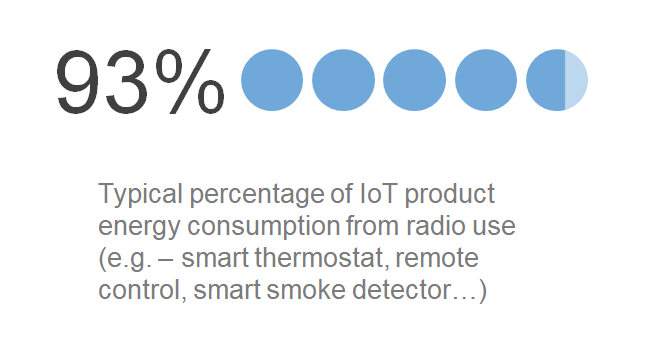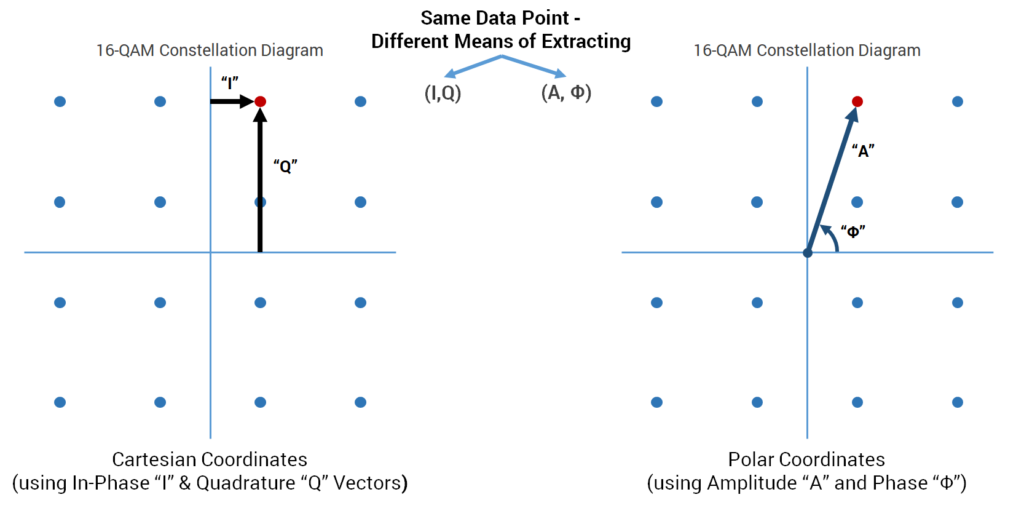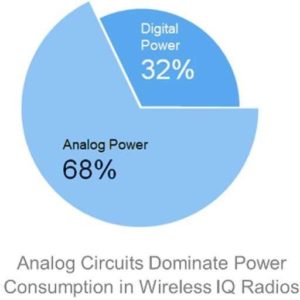The Issue
Wireless Power Consumption Limits Innovation of IoT Applications—Particularly Battery-Based Designs
The most critical issue holding back market development and growth of battery-based IoT solutions is the significant amount of power required by today’s “old-technology” radio architectures. Wi-Fi battery-based IoT products don’t last long enough between recharging or battery changes to be acceptable – even to the “bleeding-edge” customers. The underlying problem: basic radio signal processing architectures used by products today are all based on a 25-year old RF technique known as IQ radio data representation (In-phase and Quadrature – the way that the RF waveform data is processed inside the radio). IQ analog-based RF architectures are used in all the popular Wi-Fi, Bluetooth, Zigbee, Z-Wave and most other popular protocol radios in the market. Reducing Wi-Fi’s power consumption is critical to enable many devices to be battery powered for the first time or extending device lifespans from weeks to months or years to meet customers expectations.

The current IQ radio signal processing architecture used by leading RF semiconductor companies was developed decades ago – long before the need for low power, cloud-connected IoT applications were even a remote possibility. While IQ radios work well, they are highly dependent on using analog circuits for RF signal processing. The impact of depending on analog circuits within the transceiver, as opposed to digital circuits, is higher current consumption and more battery drain. Digital circuits are more efficient, have faster on/off switching and are more programmable than fixed-function, power hungry analog circuits. Also, analog does not reap the same rewards of CMOS process technology advances as digital circuits – analog circuits remain at a relatively stagnate power consumption level where digital circuits gain vast improvements.
The Breakthrough
A New Digital Polar Radio Architecture
InnoPhase IoT was founded on the premise of creating a totally new, extremely efficient and digitally-dominant radio architecture. The mission was to finally enable wireless solutions to take full advantage of the significant low power, size, integration and cost advantages that advanced semiconductor process technology brings to the market. Our team of wireless solution researchers, RF experts, and semiconductor chip designers developed an innovative technology that changes the way popular wireless solutions process RF signals. They succeeded in moving semiconductor radio signal processing from a predominantly power-hungry analog solution into highly efficient, extremely low power digital circuits.
The Design
PolaRFusionTM Digital Radio Architecture
InnoPhase IoT coined the term “PolaRFusion” to describe this major advance in the way RF signals are processed in the radio. The key differentiator is how the RF waveform is encoded and decoded using polar coordinates, amplitude and phase, in place of traditional Cartesian/IQ coordinates, in-phase and quadrature, that are used in traditional analog-based radios.

To maximize energy efficiency, we developed a specialized, low power “polar coordinate processing” architecture with optimized instruction using advanced nonlinear mathematics to encode and decode the polar data points. In addition, as radio signals travel through the PolaRFusion transceiver they can be accurately processed using software algorithms. Entire portions of the radio hardware that used to be dominated by analog blocks have been moved into digital circuits. The unique and patented flexLNA (flexible low noise amplifier) and DPA (digital power amplifier) are also implemented in standard digital CMOS circuits and major portions of the RF signal is processed using flexible, programmable software algorithms.
Overall radio power reductions for the digital PolaRFusion architecture are startling. For example, compared to the lowest power Wi-Fi wireless IQ architecture solutions in use today, batteries in low power IoT applications last 2X to 8X longer. The PolaRFusion architecture drastically reduces analog circuit power consumption by up to 65% compared to the lowest power IQ radios in use in the market today.

Another key advantage of the digital PolaRFusion architecture is that wireless protocols are not implemented in fixed hardware as in traditional IQ radios, but as flexible software programmable modules. The same hardware that executes the Wi-Fi protocol can dynamically switch to become a BLE5 long-range radio or other wireless protocol by loading a new software radio module and then switch back to Wi-Fi all in a matter of microseconds.
The Products
Implementations of the PolaRFusion Architecture
The PolaRFusion architecture has been ported to silicon, integrated with an embedded microcontroller and advanced security elements to create the Talaria TWO SoC (system on chip). This SoC platform and Talaria TWO Modules are enabling designers to create exciting new IoT products that were not possible with previous technology. They form the foundation of an entirely new set of solutions that take full advantage of the extremely efficient radio architecture and platform capabilities to make previously impractical products into reality.
The Future
Radios Back on Moore’s Law
PolarFusion based products are enabling a whole new industry – battery based IoT nodes that have data-rich, high speed cloud connections. The extreme low power RF technology eliminates the need for gateway devices and instead, offer direct-to-cloud connections. The transition of wireless solutions to the efficient world of digital circuits means they will finally be able to take advantage of Moore’s law. Unlike traditional analog radios that have hit the power consumption reduction wall, InnoPhase IoT products will continue to benefit from CMOS process technology advances – the future is very bright for PolaRFusion radios! The dream of a world of battery-based IoT devices that are always on and always connected are now a market reality.
And we are just getting started! Our RF expertise will positively impact other wireless technologies including 5G cellular and future wireless standards.
